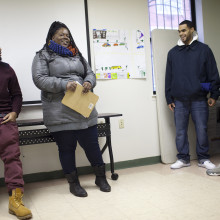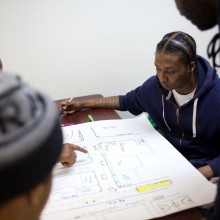In This Section:
Community benefit project planning
The Community-Benefit-Project-Planning-Flowchart is a graphic overview of the steps involved in launching a community benefit project, from the selection and approval of a project through the start of service-work. Use this tool to establish a timeline for project planning and track your progress to start-up.
Community mapping
The Community Mapping Survey is used by young adults in the NYC Justice Corps to identify needs in their neighborhoods that can lead to ideas for community benefit projects. The Survey is designed as a guide to help young adults develop a community profile and create a street map. To complete the Survey, young adults walk around their neighborhoods to assess the condition of community resources such as parks and community gardens. Young adults also interview local business owners, representatives of local nonprofit community organizations, and faith leaders. Sample interview questions are included in the Survey. There are many other ways young adults can learn about neighborhood needs such as contacting the local community board or other local government agencies. The Community Mapping Survey can be downloaded and customized.
Project scoping
Project scoping is the process of determining whether a community benefit project is feasible and what resources—tools, materials, equipment, training, and so on—will be necessary to complete the project. The Community Benefit Project Scope Sheet is used by young adults to forecast their resource needs, determine how many people will be required for the work, and estimate how long it will take to complete the project. Community Benefit Project Scope Sheet Questions guide young adults and staff through the feasibility assessment. Use the Scope Sheet and Scope Sheet Questions together to develop a budget, timeline, and training plan for the project. The scoping process will yield crucial information to help the young people and staff choose service projects that can be completed successfully—on time, within budget, and within the skill set of the young adults.
Involving a community advisory board
After the scoping process, when the team of young adults have selected one or more feasible service projects, the team proposes the project(s) to a community advisory board. The board is comprised of local business people, residents, faith leaders and other members of the community who review and approve the young people’s plans for their service projects. All community benefit projects must be approved by the community advisory board before the project begins. Young adults develop their communication skills by creating PowerPoint presentations with photos of the site for the service project, a budget, and text documenting the need for the proposed project. Every youth member of the team takes part in the presentation to the community advisory board, giving them a chance to build their teamwork and public speaking skills. Sample PowerPoint presentations from the Harlem Justice Corps Marcus Garvey Harlem Hawks CAB PPT, the Harlem Justice Corps Team Justice CAB PPT, and Harlem Justice Corps Young Justice, and the QJC CAB 1 African Poetry Theatre reflect the work done by teams of young adults in the NYC Justice Corps to plan their service projects.
Each community advisory board meeting should have a printed agenda, reflecting the fact that important business is taking place and board members’ time is valued. The Harlem Justice Corps CAB Meeting Agenda is included here as a model.
At the end of the presentation, community advisory board members ask questions, give their feedback to the young people, and use the Community Benefit Project Selection Rubric to determine whether they will approve the proposed project. This tool should be distributed to advisory board members along with the Community Benefit Project Selection Rubric Scoring Guide at the beginning of the meeting to ensure that they understand the criteria for project approval. The scoring rubric asks community advisory board members to rate the extent to which the proposed project fills an unmet community need, will be visible in the neighborhood, will have a lasting impact, will teach young adults valuable skills, and otherwise meets the guidelines for community benefit projects.
The community advisory board meets with the young adults again, after the project is completed. This gives the young adults an opportunity to reflect on what they’ve learned and further hone their communication skills as they present a post-project PowerPoint that documents the completed project. This presentation typically includes an updated budget with projected and actual expenditures; before-and-after photos showing the impact of the project; and text slides describing the work that was done. The Queens Justice Corps CAB 2 Afrikan Poetry Theatre+Theater of the Oppressed is a sample post-project presentation.

















